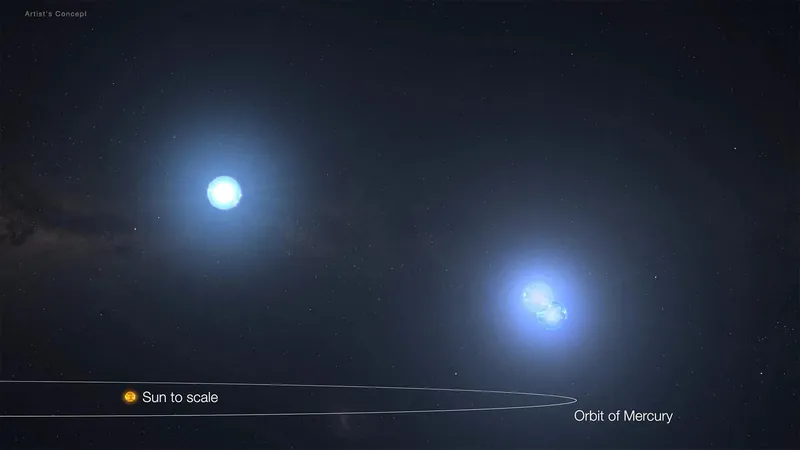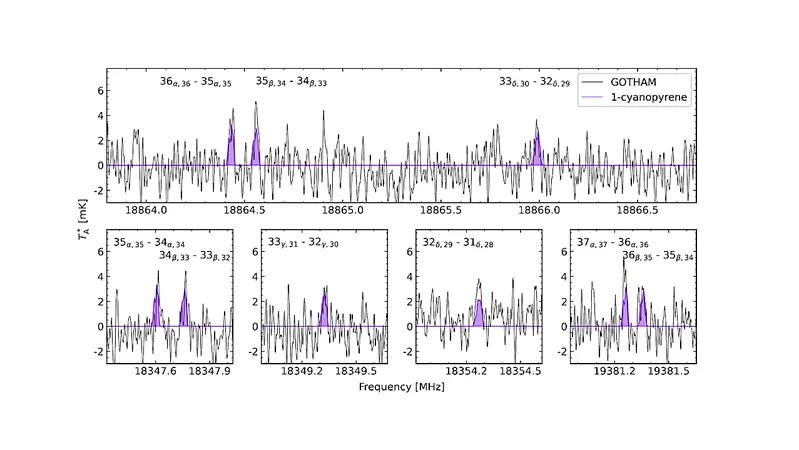
NASA and AI Join Forces to Uncover Record-Breaking Stellar Trio: What This Means for Our Understanding of the Universe!
2024-10-03
Groundbreaking Discovery
In a groundbreaking discovery, a collaboration between professional and amateur astronomers has led to the identification of a remarkable stellar trio, known as TIC 290061484, with orbits unlike any previously observed. Using NASA’s Transiting Exoplanet Survey Satellite (TESS) and advanced artificial intelligence, this team has unveiled an extraordinary cosmic phenomenon that challenges our understanding of stellar dynamics.
Remarkable Orbital Dynamics
TIC 290061484 is remarkable due to its incredibly fast orbital motions. The two innermost stars orbit each other once every 1.8 days, while the third star orbits around them every 24.5 days. To put this into perspective, the Earth takes 365 days to complete one orbit around the Sun, and Mercury’s orbit lasts a mere 88 days. In stark contrast, the Sun takes a considerable 225 million years to orbit the center of the Milky Way galaxy.
The fastest previously recorded stellar trio had an outer star circling a pair every 33.02 days, making TIC 290061484 the fastest known stellar trio of all time. This unprecedented discovery sheds light on the dynamics and evolution of such stellar systems.
Innovative Discovery Process
The discovery process was an innovative fusion of technology and amateur enthusiasm. TESS initially detected faint flickers of starlight, an indication of stellar eclipses due to the flat orientation of the system. Astronomers employed machine learning algorithms to sift through an extensive dataset of starlight, identifying moments when eclipses occurred. A dedicated group of citizen astronomers played a crucial role in further refining this data, ultimately revealing the trio of stars.
Visual Representation of the Discovery
NASA has even shared a video on YouTube that visually captures the celestial ballet of these stars, highlighting the moments of their eclipses. This visual evidence is crucial for understanding the plane in which these stars orbit, providing valuable insights into their interaction.
Significance of the Discovery
Veselin Kostov, a research scientist at NASA’s Goddard Space Flight Center, shared exciting details about the significance of this discovery, stating, 'Thanks to the compact, edge-on configuration of the system, we can accurately measure the orbits, masses, sizes, and temperatures of its stars. This research allows us to study the system's formation and make predictions about its future evolution.'
Stable Yet Changing System
The configuration of the stars, all orbiting in a plane smaller than Mercury’s orbit, suggests a stable system; their gravitational pull does not destabilize one another. This bustling group of stars may continue orbiting together indefinitely, but as they age, significant changes loom on the horizon.
Future Expectations
In an exciting twist, Kostov noted that in about 20 to 40 million years, the inner stars are expected to expand and ultimately merge, leading to a spectacular supernova explosion. This eventual cosmic fireworks display will provide further opportunities for study as astronomers monitor the outcomes of such dramatic stellar events.
Possibilities Ahead
While TIC 290061484 holds the record for the shortest orbit of any known trio to date, new possibilities lie ahead. NASA's upcoming Nancy Grace Roman Space Telescope is set to capture more detailed imagery of the Milky Way than TESS, potentially unveiling even more astonishing stellar systems with shorter orbits.
Co-author Brian Powell, a data scientist at Goddard, emphasized the importance of this next-generation telescope, stating, 'We don’t know much about many stars in the center of the galaxy except for the brightest ones. Roman’s high-resolution capabilities will allow us to measure light from stars that typically blur together, offering unprecedented insight into the nature of star systems in our galaxy.'
Conclusion
As we continue to explore the cosmos with advanced technology, discoveries like TIC 290061484 remind us of the infinite wonders that await in the universe, promoting a deeper understanding of the forces that shape our night sky. Keep your eyes on the stars and stay tuned for more thrilling celestial revelations!




 Brasil (PT)
Brasil (PT)
 Canada (EN)
Canada (EN)
 Chile (ES)
Chile (ES)
 España (ES)
España (ES)
 France (FR)
France (FR)
 Hong Kong (EN)
Hong Kong (EN)
 Italia (IT)
Italia (IT)
 日本 (JA)
日本 (JA)
 Magyarország (HU)
Magyarország (HU)
 Norge (NO)
Norge (NO)
 Polska (PL)
Polska (PL)
 Schweiz (DE)
Schweiz (DE)
 Singapore (EN)
Singapore (EN)
 Sverige (SV)
Sverige (SV)
 Suomi (FI)
Suomi (FI)
 Türkiye (TR)
Türkiye (TR)